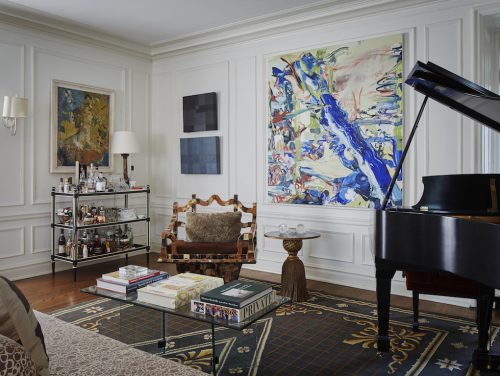
BY JUDY CARMACK BROSS
Martin Horner, a principal in the architecture and design firm Soucie Horner, Ltd., which has created distinctive interiors locally and internationally since 2000, first asks his clients about their dreams and desires. To him, the resulting architectural design tells their story.
“I look to what a person collects, where they travel, and what styles they like. What inspires a client: is it a painting, a favorite hotel, or an image? Then I ask people to use only three words to tell me what they like. The results should make a personal statement that is comfortably livable and absolutely lovely.”
What are Martin’s three words, you might wonder?
“The three words I would choose are collected, mismatched, and unexpected. “Unexpected” probably best states it because I love mixing architectural periods and styles, playing with shapes and forms. I live in a Beaux Arts apartment done in 1924, and I have a collection of vintage crystal decanters and 1920s French porcelain, many purchased a long time ago.”
Both Horner and his business partner, Shea Soucie, were educated at the École Spéciale d’Architecture in Paris, as well as the School of the Art Institute. Horner spent time at Frank Lloyd Wright’s Taliesin cataloging the many architectural treasures there.
Soucie Horner has designed cafes, offices, a high-rise, and other commercial spaces, and created custom furnishings such as rugs, lighting, furniture, and textiles. Their work takes them to London, Mexico, and the Caribbean, and across the country from Lake Tahoe and Jackson Hole to Charleston and throughout the Midwest.
Horner recently summarized their work: “Our emphasis is applying a more modern approach to classic architecture. Our clients, who range in age from 25 to 85, want that reference to history but definitely not too much ornamentation or fuss.”
We sat down with Martin recently to ask him a few questions about his beginnings, his process, and his musings.
How did you begin?
Many designers say that their first project was their childhood bedroom—mine was my GI Joe fort! I didn’t like the way it looked, so I wallpapered it, added pictures of masterpieces from the Art Institute of Chicago, and I felt it looked much better. I still have it in storage.
What are new trends in the world of design?
Where there was once a focus on kitchen design, now people want a really nice closet, with great lighting—well-outfitted for terrific organization.
Where does entertaining take place today?
People want big open spaces, but it is actually all about being around that island in the kitchen. It is the center of everything.
If you want to make a small change to your living space, what might that be?
Go for new pillows—they can change a look very quickly. And paint can change everything! Re-painting the master bathroom or the kitchen is probably the number one renovation step. Try painting moldings around windows or add wallpaper to refresh your home. Getting the right mix of direct and indirect lighting can also make a real difference—the room can function at its best and have a glow to it.
What room do you usually begin with in your design?
The master bedroom—it should be the most private and personal space in your home.
What is your approach to color?
Some people are afraid of color, so I encourage them to use neutral backgrounds and bring out color in art, rugs, and fabrics. One of my favorites is cobalt blue; it has the feel of lapis lazuli.
What about a client’s art—is it hard to place?
Good art is always easy, but sometimes it can get more complicated with other pieces. My approach is to make sure that the proportions of the art are right for the area where it is displayed.
You have said that knowing what the client loves is very important to you. What are some of the collections you have placed?
One client has possibly the premier collection of tramp art in the world, including boxes, furniture, and frames. It is all out in the home we designed for the client in Michigan. Often, whole rooms are dedicated to collections. One room we have done is all about the jade a client owns.
What is different about your approach to clients’ second homes?
What we do in each destination has to be appropriate to the local culture. Sometimes we have clients doing third and fourth homes, as well. For the most part, clients are more playful with these homes and want to take risks they wouldn’t take in their primary residences.
What is one of your more challenging assignments?
Creating a home on Virgin Gorda in the British Virgin Islands was fun and intriguing but also challenging. We had to bring everything over on a barge that landed on the beach, and it was necessary to hire a bulldozer to move it. There are definitely no hardware stores on the island, so I had to remember to take along every single extension cord we needed.
Soucie and Horner sum up their work beautifully and succinctly: “We are passionate for innovation and distinction and have an unwavering dedication to understated grace.”
To learn more about Soucie Horner, Ltd., visit soucihorner.com.

















